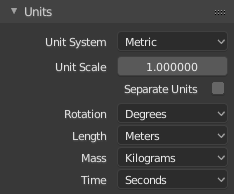Blender 2.80: More Features¶
Units¶
A primary unit can be selected for length, mass and time. This unit will be used everywhere to:
- Display values of that type in the user interface
- Parse unitless user input
The old behavior can be restored on a per unit basis by using the "Adaptive" mode, where a unit is adaptively chosen depending to match the value. When "Separate Units" is activated, the primary unit is always the first of the displayed units.
Video Sequencer¶
- Sequencer cache has been rewritten. Users can control what gets stored and what doesn't, so cache is as effective as possible. Cache usage can be visualized directly on timeline (337cac760b)
- Text strips support for selecting a font. (b3dbe17658)
- Add many more blend modes and a new Color Mix strip. (4b4702ab8)
Physics¶
Cloth¶
Angular bending springs were implemented and are now the default. Angular springs are generally much more realistic, but can cause some instability with extremely high bending stiffness at low sampling rates. The linear bending model is still available and is the default when opening existing simulations. (b6f0f8a5b5)
Structural cloth forces are now separated into components, allowing individual stiffness and damping control over tension, compression, and shearing (in addition to bending). N-gons are now properly supported, having shearing springs added to them, preventing them from collapsing. (e3d31b8dfb)
Collisions¶
Cloth collisions underwent a major overhaul to improve reliability and stability (0666ece2e2).
- More accurate self-collisions.
- Optimizations for multicore CPUs.
- Single-sided collision support, to prevent e.g. cloth getting stuck inside a body mesh.
- Support for different fricition per collider object.
- Simultaneous collisions and impulse clamping for more reliable collision.
Effectors¶
- Effectors can now have a infinite line shape, in addition to points, infinite planes and meshes. (969cbed)
Rigid Bodies¶
- The Generic Spring constraint now uses the newer Bullet spring implementation with better damping behavior, but the old version is available as an option. (26a283d, ec64051)
Image Objects¶
The new image objects replace the old background images in Blender, to be organized and transformed as part of the scene.
These can be added from the Add object menu, or by drag and drop into the 3D viewport.
Drop .blend files¶
When dropping a .blend in Blender there is now the choice to load the file, append something from it or link to it.
Datablocks¶
- Copy/paste of any kind of data-block is now possible in the outliner.
- Delete data-blocks (including purging orphaned data) can now be undone.
- Deleting many data-blocks from the outliner is now much faster.
- Scene duplication options 'Linked Objects' and 'Linked Object Data' have been removed, instead collections can be used for easy linking of objects across scenes. A new 'Linked Collections' option was added which creates a full shallow copy of the scene.
Audio¶
Audaspace was updated to the latest version, which includes many stability and performance improvements. Different OpenAL devices can now be chosen in the user preferences.
New features in the Audaspace Python API include:
- Play self generated sounds using numpy arrays.
- For games: Sound list, random sounds and dynamic music.
- Writing sounds to files.
- Sequencing API.
- Opening sound devices, eg. Jack.
Sculpting¶
- Topology Rake aligns edges along the brush direction while painting. This helps to generate cleaner topology and define sharp features with dynamic topology. Best used on relatively low-poly meshes, it is not needed as much for high detail areas and has a performance impact. (b592e34)
- Manual detail mode for dynamic topology. In this mode mesh detail does not change on each stroke, only when using flood fill. (2203b04)
Weight Paint¶
- A new viewport shader option to display contours formed by points with the same interpolated weight. (ba3ef44a)
Compositor¶
- The RGB Curves now supports Film Like curve mapping, used for adjusting saturation and contrast, while avoiding color shifts. It does this by balancing the color channels to preserve the hue. (4de7c0c31)
Preferences¶
- Added two simple options that control the tablet pressure response curve globally within Blender (539b465b).
